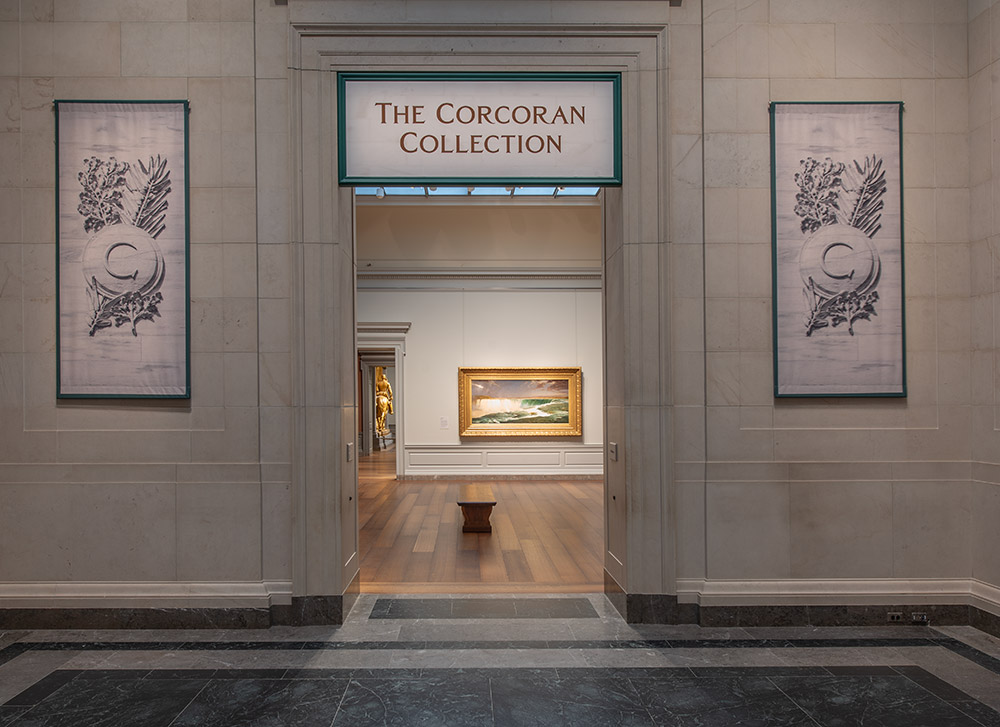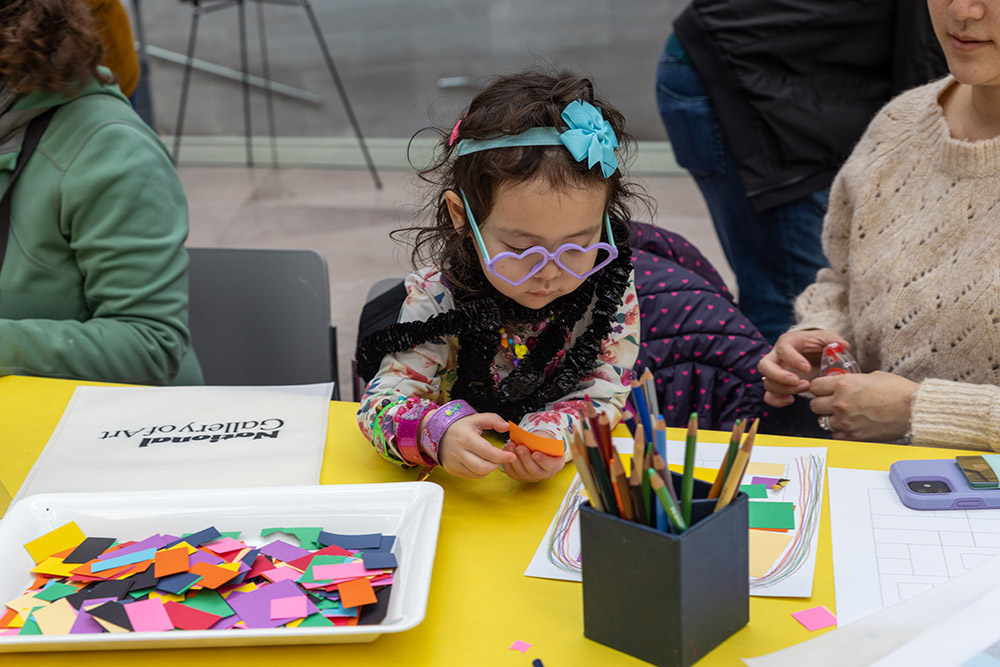Deepening public understanding and appreciation of art and visual culture is at the core of the National Gallery’s exhibitions, educational programs, and outreach efforts. We are here to preserve and share art, as well as encourage curiosity and continuous learning, inviting visitors to see the world through new lenses and to appreciate the perspectives that others bring. We recognize the museum’s potential to be a source of unity, a place where empathy and understanding can flourish. Together, we will continue to create spaces and experiences that bring people together, inspiring a sense of wonder and encouraging dialogues that transcend time and place.
Kaywin Feldman
Director
Superlative Works of Art Join the Nation’s Art Collection

Leonardo da Vinci, Grotesque Head of an Old Woman, 1489/1490, pen and brown ink on laid paper; laid down, Gift of Dian Woodner, 2022.84.1. More of Leonardo da Vinci’s drawings have survived than those by any other artist of the Italian Renaissance. Leonardo’s Grotesque Head of an Old Woman—one of a series of some 30 studies, identical in small format, style, and technique—is the second of his drawings to join the National Gallery’s collection. There are just nine other Leonardo drawings in American public collections.
Each work of art that enters the National Gallery’s permanent collection represents an inspirational story of private generosity. Like the gifts of art given in the second third of the twentieth century to form the nucleus of the nation’s collection, all acquisitions since have been made possible by individuals who donate art or funds to purchase works of art for the nation.
This fiscal year 1,748 works joined the National Gallery’s permanent collection, including Leonardo da Vinci’s Grotesque Head of an Old Woman (1489/1490); a group of etchings from Teodoro Filippo di Liagno’s Animal Skeletons series (1620–1621); three drawings (1968, 1973, and 2010) by Jack Whitten; a selection of more than 100 prints created by 50 artists at the Brandywine Workshop and Archives since its founding in 1972; the Ross J. Kelbaugh Collection, which comprises 248 photographs of and by African Americans made from the 1840s through the early 20th century; 4 photographs from Tseng Kwong Chi’s East Meets West series(1979–1987); Nautilus Cup (c. 1650, etching; c. 1670, mount), an extraordinary object that may have been made for a member of the Swedish royal family; Fede Galizia’s Still Life of Apples, Pears, Cucumbers, Figs, and a Melon (c. 1625–1630); Beatriz Milhazes’s Romantico americano (1998); and Simone Leigh’s Sentinel (2022), a new edition of the sculpture from the US pavilion at the 2022 Venice Biennale. Press releases about select acquisitions are available on the National Gallery’s website.
Exhibitions Highlight New Discoveries and a Range of Artists
Watch as master sculptor Fred X. Brownstein recreates Antonio Canova’s sculpture Venus using Canova’s unique 200-year-old techniques over the course of 6 months. This captivating video accompanied the exhibition Canova: Sketching in Clay. By displaying Canova’s preparatory models alongside some of his finest marbles, the exhibition invited visitors to contemplate how an artist renowned for the polished perfection of these sculptures could have developed them from a style of modeling that was so expressive, so rough and immediate.
This year, the National Gallery presented a diverse slate of exhibitions, from highly anticipated, large loan exhibitions such as Sargent and Spain and Philip Guston Now, to smaller—and equally popular—shows drawn from the permanent collection, like Going through Hell: The Divine Dante and Vermeer’s Secrets. Scores of visitors lined up to see Vermeer’s Secrets, a tightly focused exhibition that presented new findings illuminating aspects of the Dutch master’s working methods and suggesting the existence of a studio of Vermeer.
Vittore Carpaccio: Master Storyteller of Renaissance Venice was the first retrospective of the artist outside of Italy. Conservation treatment of the National Gallery’s Virgin Reading (c. 1505) revealed a baby Jesus previously hidden beneath a later repainting that sought to disguise where the painting had been cut down centuries ago.
Artist Jaune Quick-to-See Smith (Citizen of the Confederated Salish and Kootenai Nation) curated The Land Carries Our Ancestors: Contemporary Art by Native Americans, an exhibition that highlighted artworks by nearly 50 living Native artists. As the first artist to curate an exhibition at the National Gallery, Smith underscored the self-determination, survivance, and right to self-representation of Indigenous peoples in her selection of artworks.
Canova: Sketching in Clay explored Antonio Canova’s process—detailing how he designed in clay and how he moved from sketch to finished statue. After developing his ideas in clay—a step that is demonstrated in an award-winning and wildly popular video made for the exhibition—Canova made increasingly larger models that were cast in plaster. Assistants used the pointing system to copy plaster into marble, which Canova then finished.
The National Gallery of Art, George Washington University, and the Trustees of the Corcoran Gallery Advance Historic Partnership

A view of Frederic Edwin Church’s Niagara (1857) and Augustus Saint-Gaudens’s The Shaw 54th Regiment Memorial (1900) at the entrance to the Corcoran Legacy Gallery on the Main Floor of the National Gallery’s West Building. Courtesy of the National Gallery of Art Archives.
The Corcoran School of the Arts and Design at the George Washington University (GW), the National Gallery of Art, and the Trustees of the Corcoran Gallery of Art announced a reimagined partnership that includes a future home to foster education and creativity at the Corcoran School as well as the establishment of a Corcoran Legacy Gallery and other resources. The partnership, a revision to the 2014 agreement following the closing of the Corcoran Gallery, draws on each institution’s respective strengths to amplify Corcoran’s historical legacy and supports students and emerging artists via robust programmatic and educational partnerships, benefiting millions of museumgoers and the next generation of students at GW.
Video Series Explores Contemporary Artists and Their Communities Across the Nation
This episode of West to East reminds us that Indigenous teachings and culture are vital guides in reshaping how we connect with places, one another, and the universe, and it asserts histories that existed long before this land was known as the United States of America. Viewers discover the ways that meteorites, steel, and blankets carry stories into the future.
The National Gallery launched West to East, a cross-country video series that documents contemporary artists whose work explores connections to their local communities and to the nation at large. Through interviews and extensive footage captured on location, the series focuses on artists across the United States.
In the first episode of the series, Marie Watt (Seneca Nation of Indians/European descent, b. 1967) talks about Turtle Island and its connection to her work, family, and Native American history. Interwoven with Watt’s story is the tale of Tomanowos, a sacred meteorite that shaped the geology and history of the Willamette Valley in Oregon, where Watt lives and works. The story of Tomanowos was nearly lost until the Confederated Tribes of Grand Ronde reclaimed it and restored it to prominence.
First Saturdays Program Offers Immersive, Multigenerational Experiences

A young visitor enjoys making art at First Saturdays, a new monthly program at the National Gallery of Art.
Art enthusiasts, visitors to the nation’s capital, locals, families, and children of all ages have a new favorite spot to gather and connect with art and with each other. First Saturdays is a monthly program designed by the National Gallery to serve a range of audiences. On the first Saturday of each month, visitors are invited to enjoy activities such as films, art making, talks, tours, and pop-up performances. The offerings vary based on theme and the time of year.
The inaugural event celebrated Called to Create: Black Artists of the American South and began with kids’ films from the New York International Children's Film Festival. Drop-in art making inspired by works in Called to Create was extremely popular, as were special exhibition tours led by National Gallery educators. Throughout the day, our pop-up library displayed rare books and art images from our collection.
